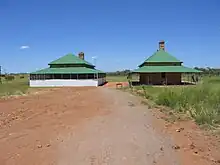

The Tennant Creek Telegraph Station is an historical site about 16 kilometres north of Tennant Creek in the Northern Territory of Australia.
History
The Warumungu Aboriginal people were the first occupants of the region in and around Tennant Creek. The telegraph station is near a very significant sacred site called "Jurnkurakurr", which is home to a Dreamtime being called "Jalawala", a black-nosed python.[1]
The Tennant Creek Telegraph Station was built in 1872. It was first a temporary bush timber building but by 1875 had been rebuilt with locally quarried stone.[2] It operated as a repeater station as part of the Overland Telegraph Line which connected Darwin to Adelaide. It also operated as a government rations depot. By the 1920s it featured a blacksmith shop, cart shed, ration store, meat house, smokehouse and cellar. Warumungu people were employed at the station as cattlemen and slaughter-men. But the 1890s more than 100 Aboriginal people were living at the station. It was declared an Aboriginal Reserve.[3]
The search for gold began from the 1880s.[4] In 1925, a linesman discovered gold, with the discovery quickly leading to the establishment of a township to the south of the telegraph station. In 1935 a post and wireless office became operational in the town of Tennant Creek itself,[5] so that the telegraph station was closed. It then reverted to a rations depot, supplying meat to the new town and water from its bore until 1966.[6]
Postmasters

| Postmasters/Managers | From | To |
|---|---|---|
| Alan M. Giles[7] | 1875 | 1888 |
| Henry Herbert Dixon | 1915 | 1923 |
| J. W. M. Phillips[3] | 1926 | 1927 |
Recent history
The station was listed on the now-defunct Register of the National Estate on 25 March 1986.[8] The station was listed on the Northern Territory Heritage Register on 4 July 2001.[1] The land including the Telegraph Station and its immediate surroundings was originally proposed in 1987 as a historical reserve known as the Tennant Creek Telegraph Station Historical Reserve but progress was delayed by a claim on the land made under Aboriginal Land Rights Act (Northern Territory) in 1980 . The claim was resolved in August 2001 with the historical reserve awaiting official naming in April 2002.[9] Significant restoration work was undertaken on the remaining station buildings in 2012.[10]
References
- 1 2 "Tennant Creek Telegraph Station". NT Heritage Register. Northern Territory Government. Retrieved 19 May 2017.
- ↑ "Tennant Creek Telegraph Station Historical Reserve" (PDF). Northern Territory Government. Northern Territory Government. Retrieved 6 October 2016.
- 1 2 Ingram, David; Elcoate, Christine. Teachers' Handbook: Tennant on the Line. Conservation Commission of the Northern Territory.
- ↑ "The Search for Gold". The Express and Telegraph. Vol. XXIII, no. 6, 715. South Australia. 12 May 1886. p. 5 (Second Edition.). Retrieved 10 December 2016 – via National Library of Australia.
- ↑ "TENNANT CREEK". Northern Standard. No. 48. Northern Territory. 21 June 1935. p. 9. Retrieved 6 October 2016 – via National Library of Australia.
- ↑ Miles, Margot (1988). The Old Tennant.
- ↑ "THE NORTHERN TERRITORY". Evening Journal. Vol. XX, no. 5695. South Australia. 26 November 1888. p. 3 (SECOND EDITION). Retrieved 10 December 2016 – via National Library of Australia.
- ↑ "Tennant Creek Telegraph Station Complex, Stuart Hwy, Tennant Creek, NT, Australia- listing on the now-defunct Register of the National Estate (Place ID 13878)". Australian Heritage Database. Australian Government. 25 March 1986. Retrieved 21 June 2018.
- ↑ "TENNANT CREEK TELEGRAPH STATION HISTORICAL RESERVE Draft Plan of Management" (PDF). Parks and Wildlife Commission of the Northern Territory. April 2002. p. 1. Retrieved 20 June 2018.
- ↑ Brain, Caddie (17 May 2012). "Rebuilding our history stone by stone". Australian Broadcasting Corporation. ABC Rural. Retrieved 6 October 2016.